| Sonnet 94 | |||||||
|---|---|---|---|---|---|---|---|
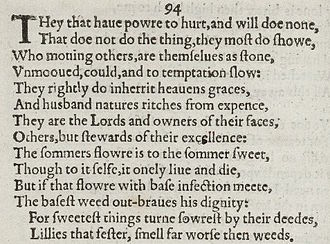 Sonnet 94 in the 1609 Quarto | |||||||
| | |||||||
| |||||||
Sonnet 94 is one of 154 sonnets written by the English playwright and poet William Shakespeare. It is a member of the Fair Youth sequence, in which the poet expresses his love towards a young man.
| Sonnet 94 | |||||||
|---|---|---|---|---|---|---|---|
 Sonnet 94 in the 1609 Quarto | |||||||
| | |||||||
| |||||||
Sonnet 94 is one of 154 sonnets written by the English playwright and poet William Shakespeare. It is a member of the Fair Youth sequence, in which the poet expresses his love towards a young man.
Sonnet 94 is an English or Shakespearean sonnet. The English sonnet has three quatrains, followed by a final rhyming couplet. It follows the typical rhyme scheme of the form, ABAB CDCD EFEF GG, and is composed in iambic pentameter, a type of poetic metre based on five pairs of metrically weak/strong syllabic positions. The 6th line exemplifies a regular iambic pentameter:
× / × / × / × / × / And husband nature's riches from expense; (94.6)
The 7th line exhibits two fairly common metrical variations: an initial reversal, and a final extrametrical syllable or feminine ending:
/ × × / × / × / × /(×) They are the lords and owners of their faces, (94.7)
Line 5 necessarily shares a feminine ending. Initial reversals also appear in lines 1, 8, and 14.
The meter demands a few variant pronunciations: line 1's "power" functions as 1 syllable, line 4's "unmovèd" as 3, and lines 9 and 11's "flower" as 1. [2]
Sonnet 94 forms part of the "Fair Youth" sequence, where in sonnets 87-96 the Youth is seen as potentially fickle and unreliable. In 90-93 the Youth seems ready to abandon the poet and forget past promises; it is possible that some act or failure to act, or some statement, in the real-life circle of the Youth's admirers has convinced the poet that his beloved is one of those who moves others but is himself "as stone", giving a false impression of his intentions. Therefore, there are grounds for cautious optimism, or so the poet thinks, for the Youth may in fact remain faithful despite past suspicions. Yet there remains the thought that some evil will still destroy the poet's hopes, and optimism may prove unfounded. [3]

Sonnet 3 is one of 154 sonnets written by the English playwright and poet William Shakespeare. It is often referred to as a procreation sonnet that falls within the Fair Youth sequence.

Sonnet 10 is one of 154 sonnets written by the English playwright and poet William Shakespeare. It is a procreation sonnet within the Fair Youth sequence.
Sonnet 17 is one of 154 sonnets written by the English playwright and poet William Shakespeare. It is the final poem of what are referred to by scholars as the procreation sonnets with which the Fair Youth sequence opens.
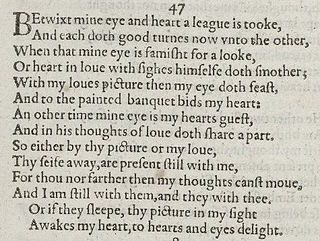
Shakespeare's Sonnet 47 is one of the Fair Youth sequence, addressed to a well-born young man. More locally, it is a thematic continuation of Sonnet 46.
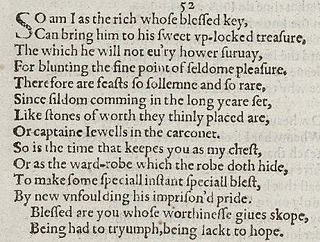
Sonnet 52 is one of 154 sonnets written by the English playwright and poet William Shakespeare. It is a member of the Fair Youth sequence, in which the poet expresses his love towards a young man.

Sonnet 61 is one of 154 sonnets written by the English playwright and poet William Shakespeare. It is a member of the Fair Youth sequence, in which the poet expresses his love towards a young man.

Sonnet 91 is one of 154 sonnets written by the English playwright and poet William Shakespeare. It's a member of the Fair Youth sequence, in which the poet expresses his love towards a young man.
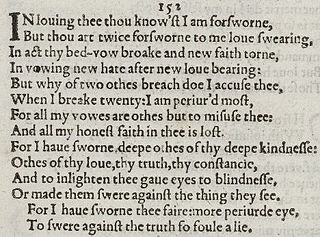
Sonnet 152 is a sonnet by William Shakespeare. It is one of a collection of 154 sonnets, dealing with themes such as the passage of time, love, beauty and mortality, first published in a 1609.

Sonnet 142 is one of 154 sonnets written by the English playwright and poet William Shakespeare.

Sonnet 75 is one of 154 sonnets written by the English playwright and poet William Shakespeare. It is a member of the Fair Youth sequence, in which the poet expresses his love towards a young man.

Sonnet 119 is one of 154 sonnets written by the English playwright and poet William Shakespeare. It's a member of the Fair Youth sequence, in which the poet expresses his love towards a young man.

Sonnet 90 is one of 154 sonnets written by the English playwright and poet William Shakespeare. It is a member of the Fair Youth sequence, in which the poet expresses his love towards a young man.

Sonnet 95 is one of 154 sonnets written by the English playwright and poet William Shakespeare. It is a member of the Fair Youth sequence, in which the poet expresses his love towards a young man.
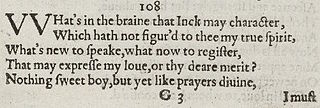
Sonnet 108 is one of 154 sonnets written by the English playwright and poet William Shakespeare. It is a member of the Fair Youth sequence, in which the poet expresses his love towards a young man.

Sonnet 111 is one of 154 sonnets written by the English playwright and poet William Shakespeare. It is a member of the Fair Youth sequence, in which the poet expresses his love towards a young man.
Sonnet 113 is one of 154 sonnets written by the English playwright and poet William Shakespeare. It's a member of the Fair Youth sequence, in which the poet expresses his love towards a young man.

Sonnet 114 is one of 154 sonnets written by the English playwright and poet William Shakespeare. It is a member of the Fair Youth sequence, in which the poet expresses his love towards a young man.

Sonnet 115 is one of 154 sonnets written by the English playwright and poet William Shakespeare. It is a member of the Fair Youth sequence, in which the poet expresses his love towards a young man.
Sonnet 120 is one of 154 sonnets written by the English playwright and poet William Shakespeare. It's a member of the Fair Youth sequence, in which the poet expresses his love towards a young man.

Sonnet 121 is one of 154 sonnets written by the English playwright and poet William Shakespeare. It is a member of the Fair Youth sequence, in which the poet expresses his love towards his young lover.